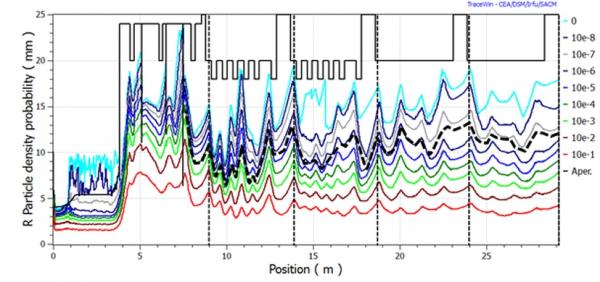
BEAM DYNAMICS
CEA is in charge of simulating beam dynamics (protons and deuterons, currents ranging from 40 µA to 5 mA, delivered energy of 1.3 MeV/u at 40 MeV) across the entire linac (including the RFQ), taking into account alignment errors and statistically probable fields in the components. Losses must be kept below 1 nA/m (2·10-7 /m) beyond 20 MeV.
The Israeli project SARAF (Soreq Applied Research Accelerator Facility) will provide an intense source of fast neutrons and radioactive nuclei with a view to exploring rare nuclear reactions and producing radionuclides for nuclear medicine. Their moderation will also produce enough neutrons to achieve functions (such as neutrography) that can only be performed today by using nuclear reactors. The neutrons will be generated through the interaction of a 5-mA proton or deuteron beam (at energy levels of up to 40 MeV) and several specific targets.
In 2003, the Soreq Nuclear Research Center (SNRC) began Phase 1 of the SARAF project, which has since entered into operation. The facility consists of:
? a 5-mA continuous proton or deuteron source,
? a low-energy beam transport section driving the beam up to the entrance of the RFQ,
? a 4-rod RFQ with an output energy of 1.5 MeV/u,
? and a prototype cryomodule containing three solenoid coils and six superconducting cavities that raise beam energy to a few MeV.
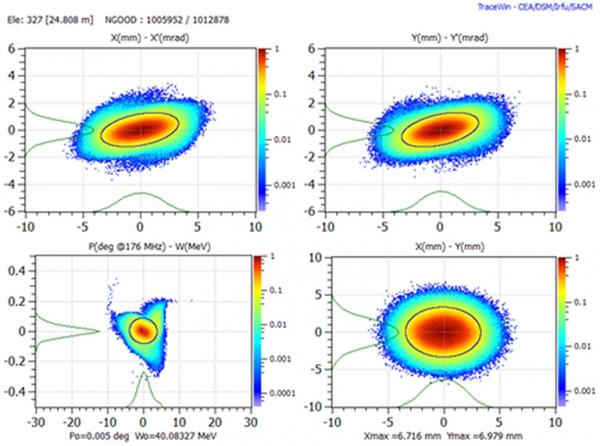
BEAM DYNAMICS
CEA is in charge of simulating beam dynamics (protons and deuterons, currents ranging from 40 µA to 5 mA, delivered energy of 1.3 MeV/u at 40 MeV) across the entire linac (including the RFQ), taking into account alignment errors and statistically probable fields in the components. Losses must be kept below 1 nA/m (2·10-7 /m) beyond 20 MeV.
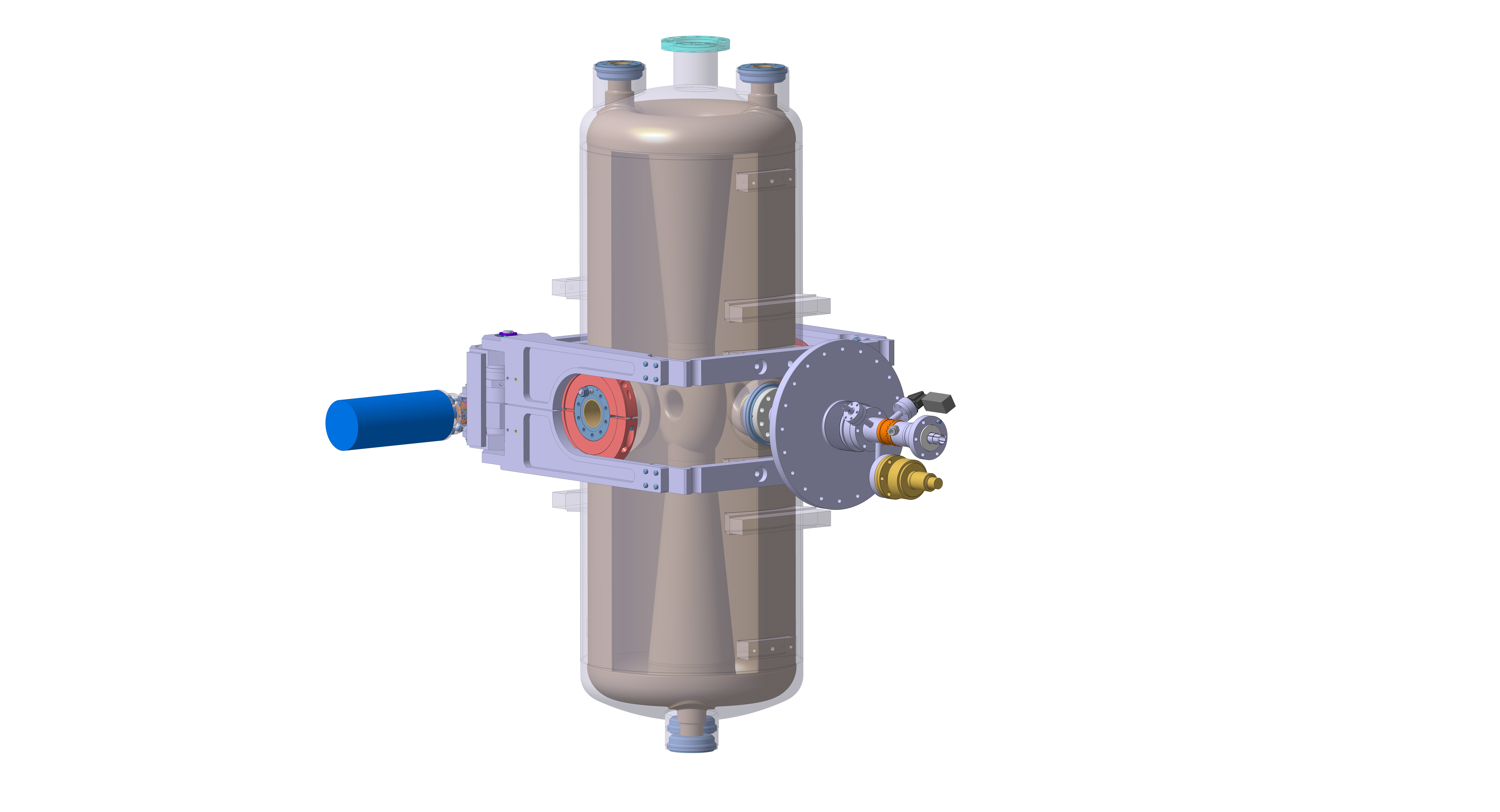
SUPERCONDUCTING CAVITIES
Two types of 176-MHz superconducting cavities are used:
The first 12 are designed for a beam operating at reduced speed (? = 0.091), for a length of 280 mm and a maximum accelerating field of 6.5 MV/m.
In 2012, the Israel Atomic Energy Commission (IAEC), who is funding this project, contacted CEA, asking them to supply the linear accelerator (linac) for Phase 2, designed to raise beam energy up to 40 MeV.
During the preliminary design phase, IRFU and GANIL worked together on an initial solution largely inspired by the SPIRAL2 88-MHz linac currently in the commissioning phase at GANIL, followed by another solution operating at 176 MHz, more compatible with the Phase 1 components and inspired by the IFMIF accelerator. This solution was proposed in a System Design Report (SDR) at the end of 2014, which served as the design basis for the memorandum of understanding signed between IAEC and CEA.
The SARAF linac project, led by LEDA at SACM, thus began early in 2015, covering design (2015-2018), construction (2018-2021), installation and start-up at SNRC (2021-2022) of the medium-energy beam transport (MEBT) section and the four cryomodules that form the linac (for a total length of 25 m).
The five-meter long MEBT line serves mainly to match the beam (generated by a modified version of the Phase 1 four-rod RFQ) to the superconducting linac. It contains three rebunchers (copper RF cavities), eight magnetic quadrupoles, diagnostic systems, and components used to characterize and filter the beam.
The superconducting accelerator consists of four cryomodules, each 5 m long. The first two are identical, containing six solenoid packages and six low-beta superconducting cavities. The following two are also identical, and contain four solenoid packages and seven high-beta superconducting cavities.
"Major” components, i.e. those featuring a known technical risk, will be produced as prototypes or first-article components until the beginning of 2018. These items include:
? the rebuncher on the MEBT line,
? the two superconducting cavities (high- and low-beta) and the RF couplers that feed them,
? the superconducting solenoid package.
The functions and technical solutions for these components were agreed upon at the preliminary design review held in October 2015. The technical specifications were approved at the critical design review in June 2016.
Cryomodule technical specifications (insert 4) will be set at the end of 2017, leading the way to four years of manufacturing, assembly and testing at Saclay, followed by transport, installation and commissioning at SNRC. The first full-energy beam is scheduled for mid-2022. All six SACM units are contributing to the SARAF project:

SUPERCONDUCTING MAGNETS
Five superconducting coils combine to form the magnet:
the main solenoid coil producing a maximum field of 6.4 T along the axis,
two solenoid coils on either side of the main magnet to reduce the fringe field on the cavities,
two pairs of horizontal and vertical deviation coils inserted between the two solenoid coils mentioned above.
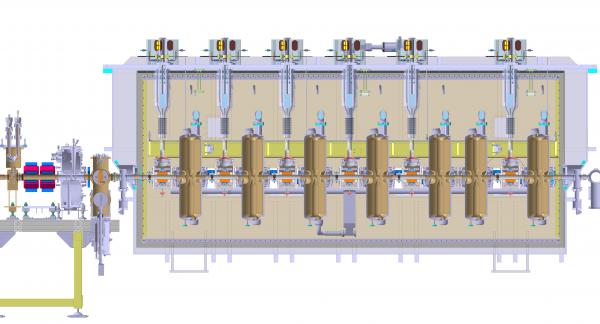
CRYOMODULES
The four cryomodules, 5 m long, must maintain the required operating conditions for cavities and magnets, i.e.:
by supplying the current and the associated RF power couplers required for operation,
by keeping them at a constant temperature of 4.45 K by supplying liquid helium and removing helium gas,
by keeping these components at a distance of +/- 1 mm around the beam axis, regardless of the movement caused by applying vacuum conditions or when thermal contractions occur.
LEDA is in charge of technical project management and beam dynamics (insert 1).
DIR is in charge of project administration.
LISAH is responsible for developing the superconducting cavities (insert 2).
LEAS is in charge of developing the superconducting magnets (insert 3).
LIDC2 oversees development of the cryomodules and the associated test activities (insert 4).
LCSE is responsible for testing the superconducting magnets and designing the cryogenics system.
As is customary for all IRFU accelerator projects, the services of its systems engineering department, SIS, are also in great demand for their cross-functional expertise in control system (LDISC and LEI), mechanical design (LCAP), power supplies (LEIGE) and manufacturing supervision (LRI). IRFU departments SEDI and SPhN also contribute in areas involving beam loss detectors.
The GANIL laboratory was responsible for MEBT components (including beam diagnostics) and system control (including machine adjustment and startup).[PNI1]
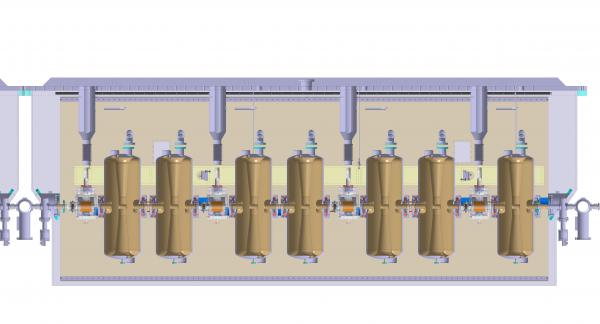
CRYOMODULES
The four cryomodules, 5 m long, must maintain the required operating conditions for cavities and magnets, i.e.:
by supplying the current and the associated RF power couplers required for operation,
by keeping them at a constant temperature of 4.45 K by supplying liquid helium and removing helium gas,
by keeping these components at a distance of +/- 1 mm around the beam axis, regardless of the movement caused by applying vacuum conditions or when thermal contractions occur.
• Accelerator physics and technology › Electron-positron linear accelerators superconducting magnet physics and technology
